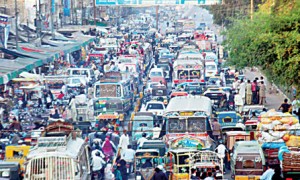By Salman Sheikh
Karachi being Pakistan’s largest city and one of the fast growing cities in the world today in terms of population, one can hardly question the need for expanding its public transport system. Increasing population being one thing, the poor quality of public transport system itself demands massive structural changes.
The rapid global urbanisation phenomenon brings with it problems of urban congestion and mobility. A major contributor to the growing chaos and degradation in Karachi is the city’s failure to put in place a mass transit system to cater to a population now ranging anywhere between 20 and 30 million people.
According to estimates, 60 per cent of Karachi’s 24.2 million daily trips are realised through the existing buses and motor rickshaws. Meanwhile, the number of registered public buses has declined from 22,313 in 2011 to 12,399 in 2014. However, after working with various ideas, it appears that there is finally hope that Karachi may now actually get to experiment with its first public mass transit system – the Bus Rapid Transit (BRT) model.
The BRT system was first proposed for Karachi in the ‘Public-Private based environmental friendly public transport system for Karachi (2006)’. Subsequently, the Asian Development Bank (ADB) took over the BRT projects as a part of the Megacity Project and identified three priority corridors. However, the ADB withdrew the BRT project in 2007.
The Karachi Transportation Improvement Project (KTIP) was later conducted by the Japan International Cooperation Agency (Jica), in collaboration with the Karachi Mass Transit Cell (KMTC) of the city government. After the master plan stage, Jica selected two BRT corridors, namely the Green Line and the Red Line.
 As it now stands, the status of the BRT lines is following different funding and management models. In the Yellow Line, a public private participation (PPP) model is proposed through a consortium. In the Blue Line, again there is a PPP model with an unsolicited proposal being made by Bahria Town. In the Green Line, there is public sector funding for infrastructure only. In the Red Line, the ADB is willing to provide a loan for detailed design, implementation and integration of the network.
As it now stands, the status of the BRT lines is following different funding and management models. In the Yellow Line, a public private participation (PPP) model is proposed through a consortium. In the Blue Line, again there is a PPP model with an unsolicited proposal being made by Bahria Town. In the Green Line, there is public sector funding for infrastructure only. In the Red Line, the ADB is willing to provide a loan for detailed design, implementation and integration of the network.
As is quite evident, for each planned corridor there are separate consultants, contractors and operators and computerised ticketing systems. Therefore, the question of how will the coordination among all these separate entities take place and by whom? The consultants were not able to satisfy the public on this count although they agreed that it was a very important issue and that without addressing it there would be severe problems.
The BRT corridor will generate offsite drainage, sewage, water supply and traffic engineering components that the city government will have to design, manage and maintain. The institutional relationship between the city government and the project, given the former`s severe limitations, needs to be clearly spelt out.
Since the 2000s, the BRT system has been introduced in a number of cities in the world, including Taipei, Seoul, Jakarta, Beijing, New Delhi, Istanbul, Lima and Bangkok. Presently, an average of 27 million people — 1 per cent — of the global urban population use the BRT each day. A total of 15 cities started BRT operations in 2010, 49 have BRT under construction while 31 are starting to plan.
While the BRT system bodes well for Karachi, it is imperative that lessons learnt from the unsuccessful experimentations made in the metropolis in the past are made an essential part of the planning process so that plans and designs on paper find a viable and sustainable space on the ground through effective implementation.




















